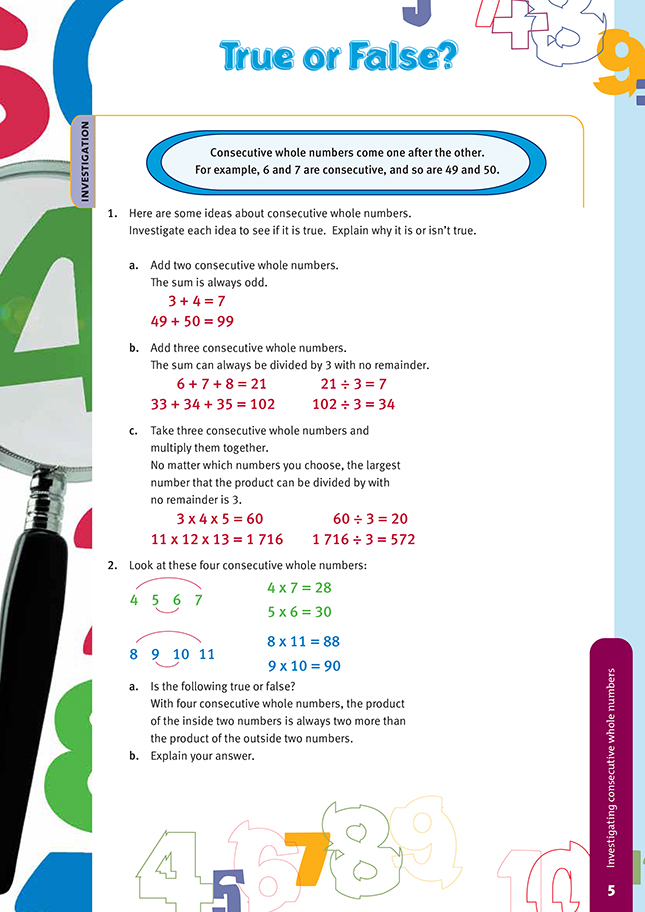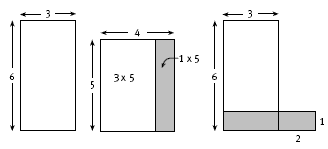This is a level 4 algebra link activity from the Figure It Out series.
A PDF of the student activity is included.
Click on the image to enlarge it. Click again to close. Download PDF (179 KB)
investigate patterns of adding and multiplying consecutive numbers
FIO, Link, Number, Book Five, True or False? page 5
To determine whether a statement is true requires not only checking out several examples that fit the statement but also using logic to justify a position taken. For example, in investigation 1a, the students could check that the sums of such consecutive numbers as 4 + 5, 15 + 16, 36 + 37 are odd and then use logic to point
out that two consecutive numbers are always going to include one even and one odd number and that the sum of an odd and even is always odd, so the statement must be true.
With investigation 1b, you may need to help the students to realise that adding three consecutive whole numbers results in a sum that is always three times greater that the middle number. In the case of the example given (6 + 7 + 8), the students should easily see that this equation is the same as 7 + 7 + 7 (and that the mean or average of the three numbers that add up to 21 is 7). It follows logically that if the sum is three times greater than the middle number, the sum can always be divided evenly by 3.
The key word in investigation 1c is “any”. If this word is ignored, the students may fall into the trap of thinking that the true solution is the product itself. If the statement had been that the largest number that the product of any three consecutive numbers can be divided by is 6, the students would be unable to find any exceptions.
To determine whether a statement is false, it is only necessary to find one instance that doesn’t conform. In this case, 1 x 2 x 3 = 6, so 6 is the largest multiple for the three smallest consecutive whole numbers and is therefore the largest divisor.
Investigation 2 shows once again the power of patterns in number. The students will probably want to try several more examples to see if the pattern holds, but they are then left with the more challenging issue of why it works. You will find nice geometric and algebraic explanations or proofs in the Answers. If the students do not discover them for themselves, you could perhaps take them through these explanations. The students could find the algebraic explanation more tricky than the geometric one if they are not familiar with the multiplication involved, which is n x (n + 3) = and (n + 1)(n + 2) =. The power of this explanation, however, is that it is generalised and represents any instance of four consecutive numbers the students might like to choose.
Answers to Activity
Investigation
1. a. True. Each pair of consecutive numbers consists of one odd number and one even number, for example, 2 + 3.
2 + 3 is 2 + (2 + 1) = 2 x 2 (even) + 1, which is one more than an even number (that is, an odd number).
b. True. This is because the sum is always three times the middle number, for example, 6 + 7 + 8 = 21 and 3 x 7 = 21 or (7 – 1) + 7 + (7 + 1) = 3 x 7.
c. False. The product of any three consecutive numbers can always be divided by 6. (Each product can also be divided by other numbers, including itself, but 6 is the largest divisor that they all have in common.)
2. a. True
b. Answers will vary.
Here is one way to explain this.
Consider:
20 – 18 = 2. (It works.)
A geometric proof for this is:
Algebraically, you could write this as:
The outside product is n x (n + 3) = n2 + 3n.
The inside product is (n + 1)(n + 2) = n2 + 3n + 2 (two greater).
Let the four consecutive numbers be:


